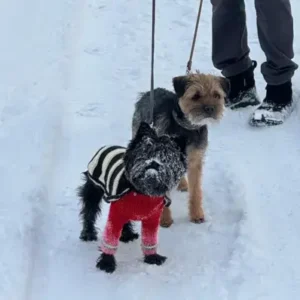Schapendoes History/Origin
The Schapendoes originated in Holland as sheepdogs on farms several centuries ago, though the exact timing is unclear. By the late 19th century, they were widely popular in the country. Like other European herding dog breeds, they worked long hours in cold, wet conditions, making their long coats essential for warmth.
Despite their native roots in the Netherlands, their popularity declined as farmers began importing Border Collies. Their population further dwindled during World War II, along with many European sheepdogs. Like the Schapendoes, the Collie is an excellent herder, known for its intelligence, agility, and strong loyalty to its family.
Fortunately, in 1947, Dutch inspector P.M.C. Toepoel advocated for the breed, leading to the establishment of a breed club and ensuring their survival. Though still small in numbers globally, the Schapendoes population remains strongest in the Netherlands, followed by other European countries, Canada, and the USA.
Schapendoes History- AKC.org
The breed was officially recognized by the Dutch Kennel Club (Raad van Beheer) in 1952, and by the FCI in 1971. The American Kennel Club currently lists this purebred dog in its Foundation Stock Service.
Schapendoes Personality
Schapendoes are known for their friendly, playful, and affectionate nature, making them wonderful companions. They are independent but relatively easy to train, enjoying tasks and challenges that keep their minds engaged.
These dogs thrive on interaction and appreciate regular playtime with their owners. Though not overly vocal, Schapendoes are vigilant and make excellent watchdogs, always alert to their surroundings without displaying aggression.
- Potential Challenges
Schapendoes can become restless and may develop destructive behaviors if not given enough physical and mental stimulation. Their independent nature, while endearing, can make training challenging, especially for first-time owners.
They may also become bored quickly if tasks are too repetitive, requiring variety in their activities. Additionally, their vigilance can sometimes lead to over-alertness, making them prone to barking if not properly managed.
Schapendoes Physical Appearance
They have a sturdy, well-balanced build and an alert, lively expression that highlights their energetic and intelligent nature.
- Size
Schapendoes typically weigh between 26 and 55 pounds and stand 16 to 20 inches tall, with males generally being larger than females. Though medium-to-large in size, their long, shaggy coats often make them appear bigger than they are.
- Coat color
Schapendoes have long, thick, shaggy coats that cover their eyes and ears, giving them a distinctive look. They are double-coated and come in a variety of colors, with the most common being white with gray or brown markings. Their coat colors can include white, black, gray, silver, brown, red, apricot, and tan, often appearing in combinations such as wide stripes or patches.
Tan Schapendoes – Source: AKC.org
Brown and White Schapendoes – Source: AKC.org
Gray Schapendoes – Source: Pinterest
Black and White Schapendoes- Source: schapendoes_abel
Schapendoes Gender Differences
Males Schapendoes are generally larger and heavier than females, with a more pronounced muscular build. While both genders share similar temperaments and characteristics, males may display a slightly more dominant demeanor, whereas females might be a bit more independent. However, these differences are often subtle and can vary from dog to dog.
Schapendoes Feed/Nutrition
Schapendoes require up to 3 cups of high-protein dry food daily, rich in healthy fats, vitamins, and minerals to fuel their bodies and maintain their long coats. Stick to an age-appropriate formula to support their development, as they don’t have any breed-specific nutritional needs.
Puppies typically eat more frequently throughout the day to sustain their energy levels. Additionally, tomatoes and potatoes can be given as a treat in moderation, but be sure to remove any stems and leaves as they can be toxic to dogs.
Schapendoes Health
The Schapendoes are a robust and healthy breed. Due to their rarity, they haven’t experienced the poor breeding practices often seen in more popular breeds. As a result, they are not prone to any significant hereditary health issues.
Schapendoes Care and Grooming
The Schapendoes is an active breed and requires at least two walks of 30 minutes to an hour each day. Engaging in dog sports can also help burn off their excess energy.
Check their ears daily for debris and pests, cleaning them as advised by your vet. Trim their nails once or twice a month to prevent them from clicking on the floor—your groomer can assist with this.
Maintain their oral health by brushing their teeth daily; if they resist, ask your vet for advice on effective brushing techniques.
Incorporate dog training tips, such as positive reinforcement, to make grooming sessions more enjoyable for you and your Schapendoes.
Despite their long, shaggy coats, Schapendoes shed very little. Brush them once or twice a week and bathe them monthly. While they are well-suited to cold, wet weather, they can overheat in hot conditions. Always provide plenty of water and bring them indoors if they show signs of overheating.
Schapendoes Rescue Groups
Schapendoes can occasionally be found through rescue organizations that focus on herding breeds or general dog rescues. These groups might have Schapendoes available for adoption or can connect you with resources to find one. Reaching out to these organizations is a good way to explore adoption opportunities.
Schapendoes Price
The price of a Schapendoes typically ranges from $1,000 to $1,500, depending on factors such as breeder reputation, pedigree, and location.
When searching for Schapendoes puppies for sale, choose breeders who follow ethical breeding practices. These breeders focus on the health and well-being of their dogs, conduct thorough health screenings, and provide a clean, caring environment.
Interesting Facts
- The Schapendoes is primarily known as a herding dog, it is also versatile in other roles such as tracking, agility, and obedience. Their intelligence and agility make them suitable for a variety of dog sports and activities.
Best For
The Schapendoes are best suited for active individuals or families who enjoy outdoor activities and have the time to provide ample exercise and mental stimulation. They are ideal for those who appreciate a loyal, independent, and social dog with a playful personality and can commit to regular grooming needs.
Top Names
| Male Schapendoes Names | Female Schapendoes Names |
| Bruno | Nala |
| Oscar | Tessa |
| Remy | Faye |
| Rufus | Greta |
| Zeke | Margo |









 Schapendoes History-
Schapendoes History- 

 Tan Schapendoes – Source:
Tan Schapendoes – Source:  Brown and White Schapendoes – Source:
Brown and White Schapendoes – Source:  Gray Schapendoes – Source:
Gray Schapendoes – Source:  Black and White Schapendoes- Source:
Black and White Schapendoes- Source: 







